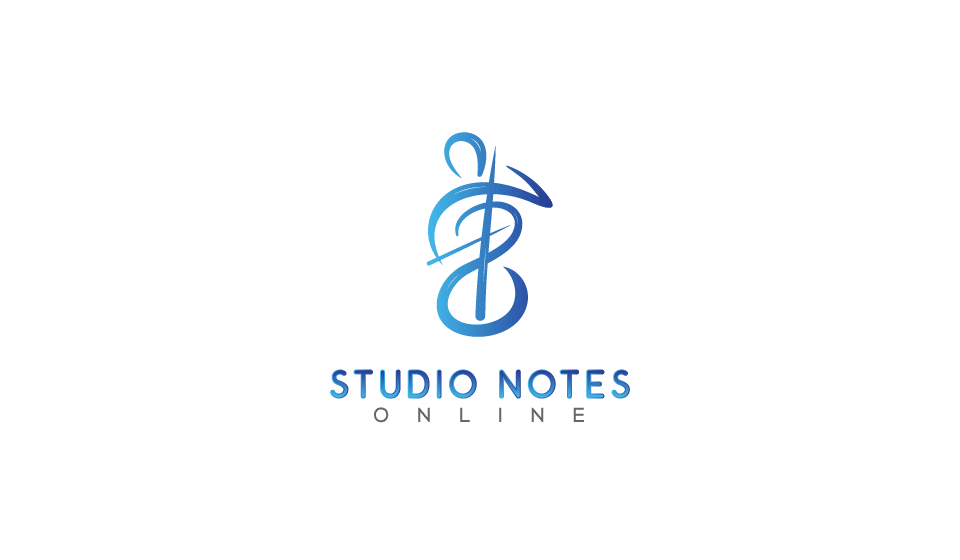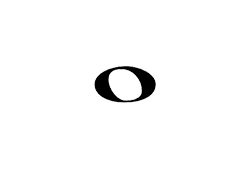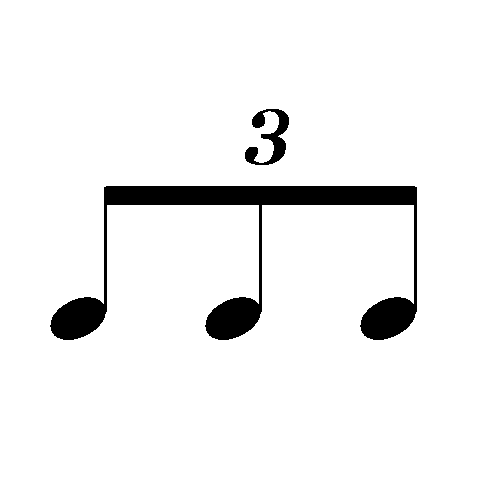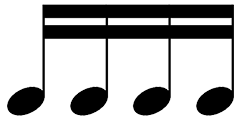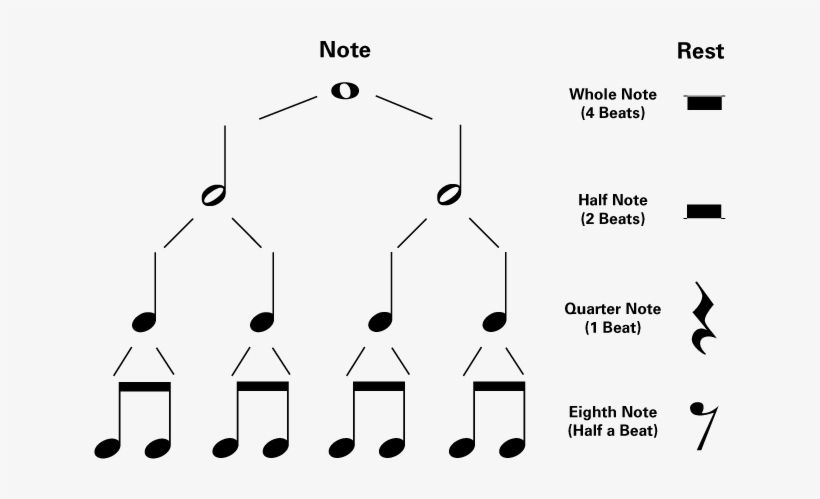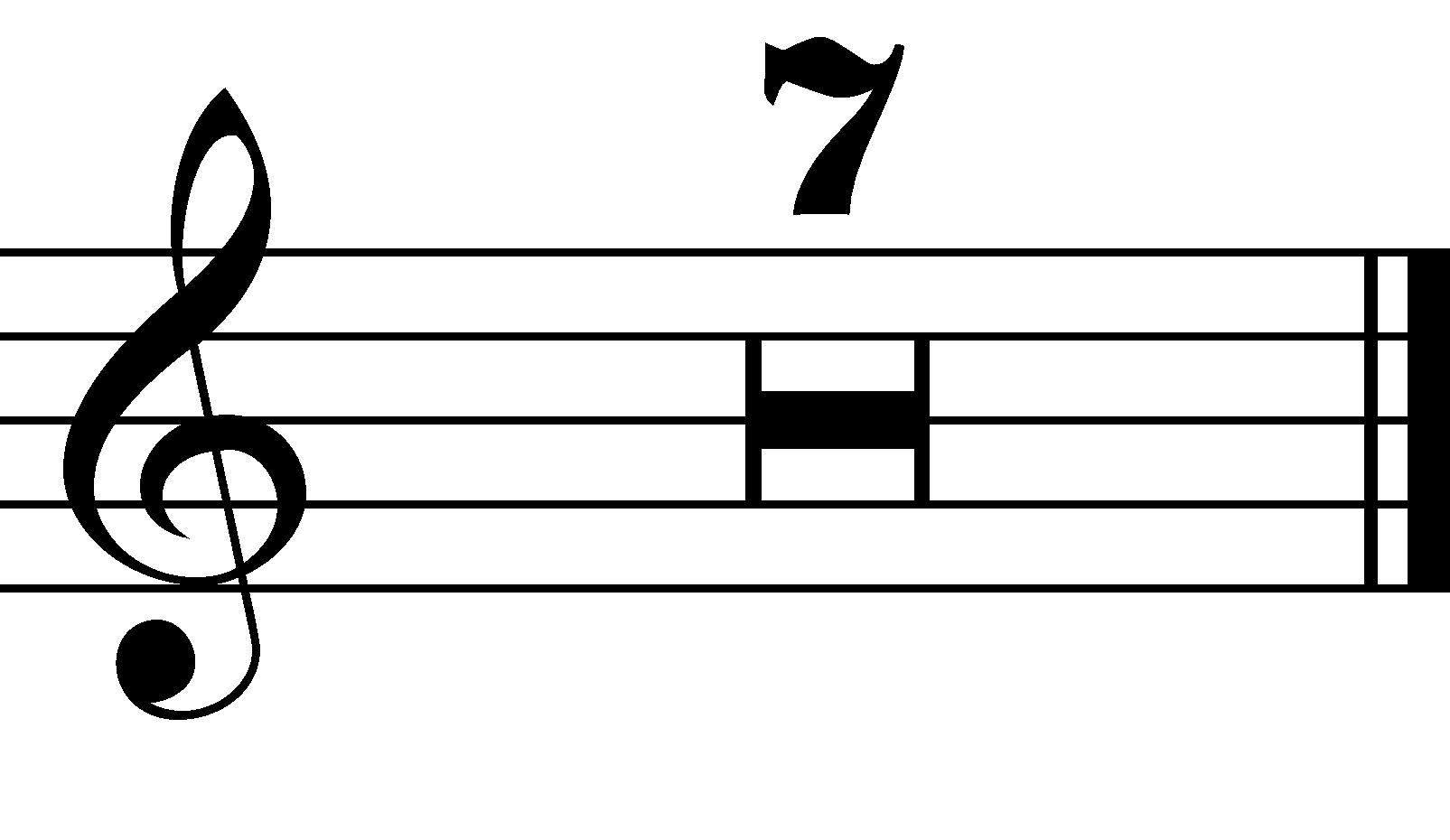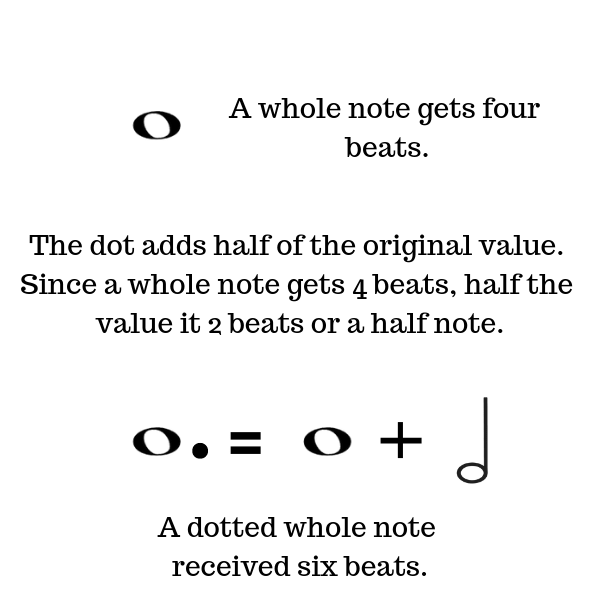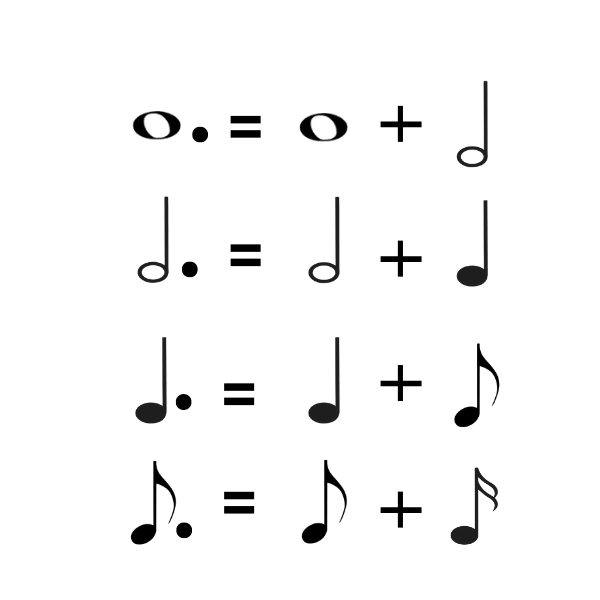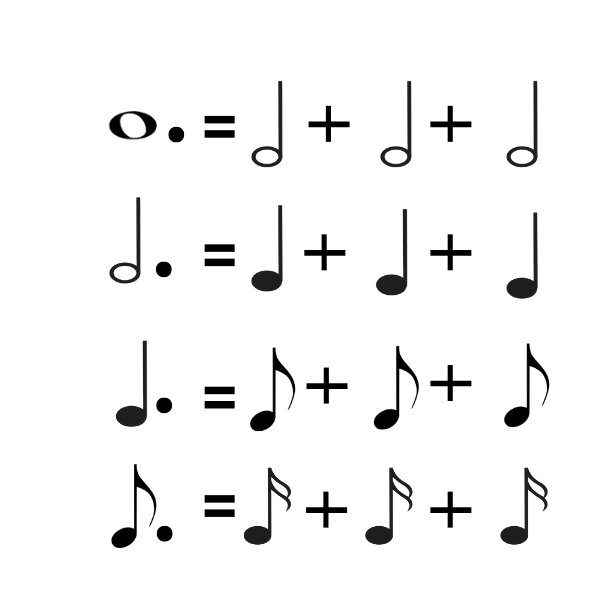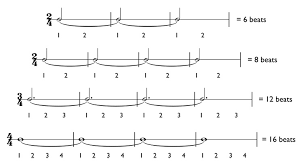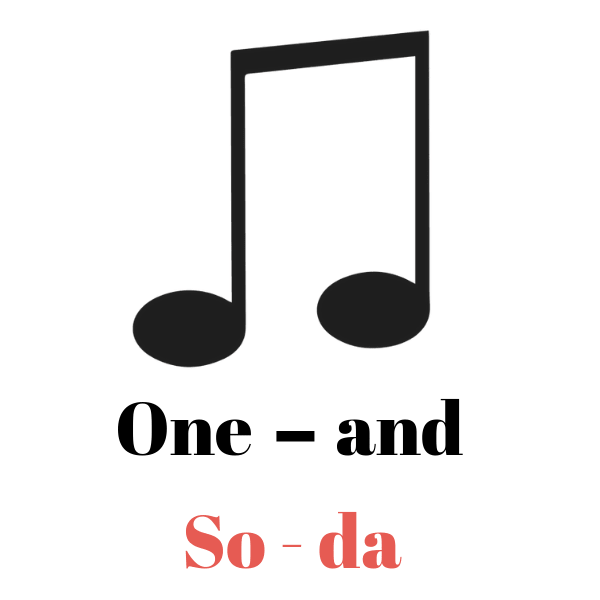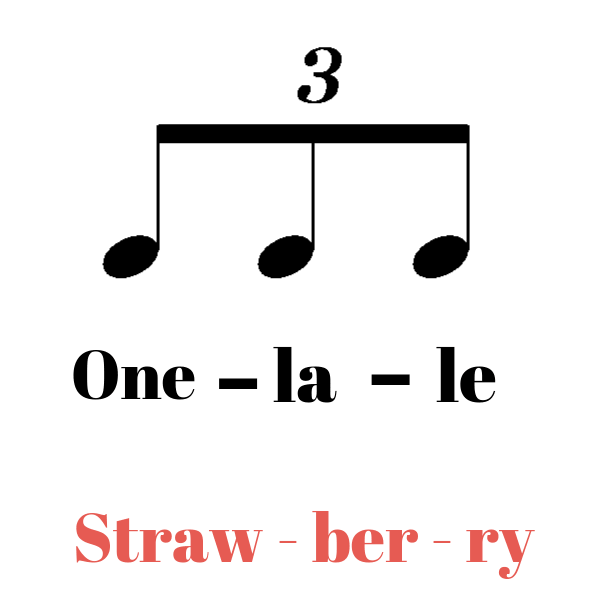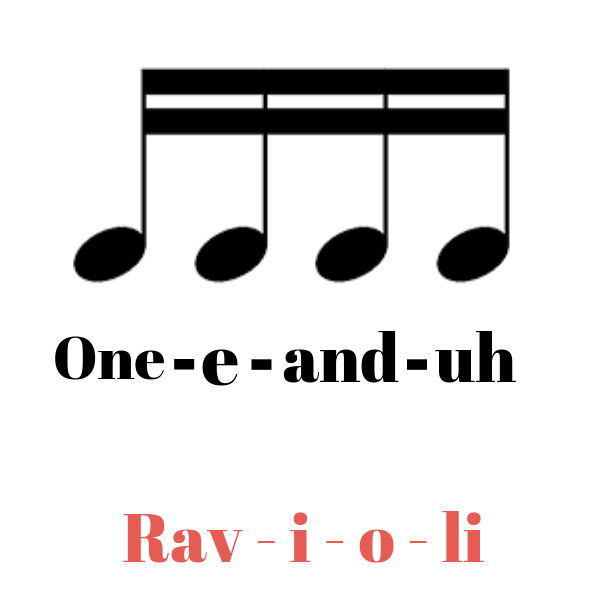I’ve worked with many teacher interns over the years, and they often ask great questions you wouldn’t usually think about.
One I had recently asked me how to describe rhythm in music to my elementary students. It got me thinking about how I need to narrow this down clearly for myself and my students.
Rhythm is the length of a sound as it exists in relation to the beat of a song or piece. Rhythms rarely exist on their own unless performed by non-pitched percussion, but it makes up an essential element of melody. Rhythms are one of the most engaging parts of a melody and accompaniment.
Let’s dig into the weeds here for some clarity on this issue.

Save time with these 60 FREE Music Resources to use in your room right away!
Stop searching the whole internet to find good activities. I’ll help you cut to the chase with my favorite 60 FREE resources.
What Is A Simple Definition Of Rhythm?
Here’s is the simplest definition of rhythm, and the one I use with my elementary-aged students:
Rhythms are the long and short sounds. It’s how the words go (if there are words).
This one gets pretty much all the way there for kids, and it hits the critical elements of rhythm.
Next, here’s a definition of rhythm in music I use with my older elementary and middle school students:
Rhythms are long and short sounds as they occur over the time of a piece and how they happen in relation to the steady beat. It tells you how long or short to sing or play each note in a melody.
Now we’re getting more and more of the essential elements into the definition.
Finally, there’s the purest, science-definition you may want to use with your oldest students or as a discussion launching point for any students:
Rhythm is when and how sounds are placed in time.
Sounds deep, right? But if you dig into it, it is the purest definition of rhythm.
Common Elements Of Rhythm
All of these definitions, and many more, will all have some of these essential parts to it:
- Length – The primary entry point for rhythm is in regards to length. A half note is this long. The eighth notes are this long. Of course, this is limited by meter and beat.
- Beat – Most of the time, rhythm exists functionally exists with a beat. We define values by whether they match the beat, divide the beat, or stretch over the beat (or both!).
- Time – We don’t need a beat to have rhythm, but we do need the dimension of time. This gets more scientific and less functional, but it’s still good to be aware of.
- Melody – Melody is not an element of rhythm, but the rhythm is an element of melody. They are tied together. After all, the melody is essentially “Rhythm + Pitch.”
You may also want to check out our guide for how to describe melody.
How Do You Describe Rhythm In A Song?
In terms of describing this musical element in a song, it’s hard for most people to isolate rhythm outside of the broader scale of melody and style.
This is perfectly fine!
The elements of music are just that, parts of the overall song or piece!
The exception is when you’re listening to purely non-pitched music, but you’ll still pick on things like articulation or style or texture/timbre even then.
Since rhythm is the length and placement of the sounds, it’s a bit tough to describe it. So don’t!
Ask about it in connection to other elements it enhances. Here are questions I ask to help realize the importance and purpose of rhythm in a greater context:
- How does the rhythm match the text of the song?
- How does the rhythm affect how the melody sounds to you?
- What is the style of the song, and how does the rhythm fit into this?
- Do you notice any repeating patterns in the rhythm?
- Where does the rhythm stand out to you? Where does it fade away?
- What is the rhythm section doing, and how does it help support the melody?
Not every question applies, but you get the idea at this point.
If there are some words you need clarification on above, check out the section at the end of this article.
Check out our helpful worksheet and activities for beat vs. rhythm.
Here’s a massive bank of descriptive words you may want to use to help your students describe the rhythm of a song.
| Long | Short | Dry | Smooth | Easy |
| Hard | Harsh | Jumpy | Repetitive | Catchy |
| Fast | Slow | Stressed | Accented | Excited |
| Connected | Separated | Rushed | Popping | Rigid |
| Flexible | Marching | Running | Sneaky | Tip-toeing |
| Happy | Sad | Angry | Joyful | Lazy |
| Energized | Frustrated | Steady | Hypnotic | Calm |
| Panicked | Creepy | Gentle | Complex | Endless |
| Crazed | Double/Duple | Triple | Dancing | Proud |
| Bouncy | Resolute | Giant | Small | Stretched |
Words Related To Rhythm You Need To Know
Beat – Beat is the invisible but felt pulse of the music. It holds the music and the rhythm together.
Meter – Meter has two main parts:
- It’s the pattern of stressed and unstressed beats in a song or piece.
- Meter tells you what written rhythmic value gets the beat and how to divide the measures.
Common meters include:
- 4/4 meter
- 3/4 meter
- 2/4 meter
- 2/2 meter
- 6/8 meter
- 9/8 meter
Measure or Bar – The song is divided into these blocks according to the meter. It helps to read and visually organize the piece.
Accent – When certain notes are stressed either in relation to the meter, articulation, or syncopation.
Syncopation – A specific type of rhythm when you have a short-long-short pattern is syncopation. The longer value is accented.
The most common occurrence of this is when you have an eighth note-quarter note-eighth note pattern.
Division – When you split the beat into two or three equal pieces, it’s called a division.
In 4/4 time, the divisions of the beat are two eighth notes. In 6/8 time, they are three eighth notes.
In 2/2 time, where the beat value is a half note, the divisions are two quarter notes.
Subdivision – Subdivision is when you split the division of the beat into equal parts (usually two but not always).
In 4/4 time, the subdivisions are four sixteenth notes. In 6/8 time, the subdivisions are six sixteenth notes.
In 2/2 time, the divisions are four eighth notes.
Ostinato – This is a special technique that highlights the rhythm itself. It’s the repeated pattern of long and short sounds for an extended period.
Tempo – This is the speed of the beat, which in turn, affects the rhythm.
Style or Articulation – Style/articulation affects how you play the melody or rhythm with other elements such as dynamics (volume), accent, and more.
Gershwin had it. Gloria Estefan warned us it was gonna get us. Janet Jackson sang of an entire nation made up of it. But when it’s at home, what is rhythm?
There’s a high probability that as a living, breathing human being you can already recognize a rhythm when it knocks on your door. But if you’re completely bewildered when it comes to understanding the nitty-gritty behind rhythm then you have come to the right place!
In this article, we’re going to look at how rhythm forms the backbone of music, core elements of the theory behind rhythm, and how to set about learning it.
Along the way we’ll see and hear some examples of rhythm in action, and take a peek at some common rhythms found in contemporary western music. By the time you finish this article you’ll be able to proudly join forces with the
Go-Gos
, and say ‘We Got The Beat’.
What Is Rhythm In Music?
It’s complicated.
When we’re talking in the context of music, rhythm can be described as patterns of notes (and the spaces between them) that are organized in time in a regular way. These can be notes with a pitch (Slash guitar playing the searing intro to ‘
Sweet Child O’ Mine
‘), or a drummer playing a beat (John Bonham’s famous drum intro for the Zep’s ‘
Rock And Roll
‘).
But it’s also more than that. Rhythm — obvious or implied — is the glue that holds a piece of music together. It’s the secret sauce that musicians sprinkle over their playing to create a ‘pocket’. It’s the groove that tugs at your feet to get them tapping.
Outside of music you can hear rhythms in nature; cuckoos singing, waves on the beach. And in man-made objects too; the ‘click-click’ of an indicator on a car dash, a train running over it’s tracks.
It’s the relationship between what you’re hearing and how you perceive it in time.
So, yeah, it’s complicated. And if you are planning on being a musician, whether performing or producing, it’s hugely important to understand how rhythm works.
Why Is Rhythm Important?
There’s a few reasons really. Firstly, without a great sense of rhythm you’re going to have a hard time playing together with your band mates / orchestra / ukelele-kazoo duo. And like with any theory, it can be a really useful shorthand when communicating with musicians and artists. While there are many elements that make up a piece of music, it’s rhythm DNA is one of the most important.
Understanding the foundations behind rhythm will also enable you to recognize or deconstruct any rhythm you hear and play it for yourself. Which leads us nicely into the deep science laboratory part of this article. Grab a cuppa and prepare to have your mind melted by compound duple time, polyrhythms, and hemi-demi-semi-quavers…
Rhythm Theory: The Core Components of Rhythm In Music
So we’ve talked about how rhythmic structure is the arrangement of notes in time. Now we’re going to deep dive into the elements that contribute to this toe-tappy organizational principle. Get ready for music theory class…
Tempo
Tempo is a fancy word to use when you’re talking about the speed of the music you’re playing. There’s a few ways to
describe the tempo
of a piece. If you’re super on the nose and say ‘it’s fast’, or ‘play it with a slow tempo’ that’s not going to help anybody since it’s a very general and subjective way of describing speed. Instead, you can use traditional Italian terms like ‘andante’, or ‘vivace’ (‘at a walking pace’, and ‘fast and lively’, respectively). There’s a whole range of them, but they’re traditionally used for classical music.
You could be more descriptive about the tempo. For instance a down tempo ambient track could be described as being
‘About The Pace You Move At After Only Three Hours Sleep’.
But the most specific way to refer to tempo is by using the BPM — Beats Per Minute. It’s also how all DAWs interpret tempo.
One other thing to remember about tempo is that it can fluctuate throughout a song. The chorus might be ever-so-slightly faster. There might be a big slowing down at the end — which you may hear referred to as a ‘rit’ (short for
‘ritardando’
— another Italian phrase from the before-times).
Notes
Playing notes of different lengths is what gives rhythms interest and movement. And understanding how these different lengths are represented in note-form will help you understand how rhythmic patterns are built.
Starting at the top of the chain, we have the
whole
note — which lasts for four beats, or counts.

Next we have the
half
note, lasting for, you guessed it, two counts!

And this guy… do I even need to tell you how long the
quarter
note lasts? You’re right — it’s one beat.

Getting into fractions now, the
eighth
note lasts half a beat.

And the
sixteenth
note lasts a quarter of a beat. Which is a little confusing, since there’s already someone with that name. But don’t shoot the messenger!

In some countries these notes have different, and slightly amusing, names:
WHOLE NOTE = Semibreve
HALF NOTE = Minim
QUARTER NOTE = Crotchet
EIGHTH NOTE = Quaver
SIXTEENTH NOTE = Semi-quaver
Confused? Hold on, there’s one more thing. A dot after a note lengthens it by half of it’s own value.
So this tiny fella

would last for one and a half beats.
Measures
In order for music not to become a sprawling mess, it’s organized into tidy little units, called measures. A rhythmic pattern can span one or more measures. And these measures are subdivided by a code called the Time Signature.
Time Signature
Those numbers you see at the beginning of a piece of sheet music? That’s a time signature. It tells us crucial information about the music. Even if you’re not
using sheet music
it’s still useful to understand how time signatures work. They’re made up of two numbers, like this:

The top number tells us how many beats are in each measure (or bar), and the bottom tells us how long each of those beats lasts. A figure ‘4’ tell us each beat is a quarter note in length, and an ‘8’ tells us each beat is, well, half a beat long, or an eighth note.
In the above example, expressed in text form as 4/4, there are four counts in every measure, and each of those counts lasts for one beat. This is one of the most common time signatures, and is pretty much the norm in most popular music. You may also come across 3/4 time (sometimes called ‘waltz time’), which has three beats per measure, and 2/4 (or ‘march time’).
Simple Time
Time signatures get described as being in simple or compound time, depending on how the shorter beats are grouped within each measure. In simple time, the shorter notes (usually eighth notes) are grouped in twos.
Compound Time
You may find some tunes in 6/8, 9/8, or 12/8. This tells us there are 6, 9, or 12, beats per measure, and each beat is the equivalent of an eighth note. Measures in these time signatures are made up of two groups of three eighth notes. These time signatures are referred to as compound time.
Odd Time
If you’re particularly unlucky your drummer might tell you that the next song is in 5/4. It’s called odd, because the notes in these time signatures are unevenly grouped. In 5/4 you may have a group of three and a group of two, or vice versa, depending on the piece of music you’re playing.
Pulse
A pulse is the (often) unplayed heartbeat of a piece of music. Even if no instruments are actually playing it, the pulse is always there. You know when your foot taps along to the music? That’s the pulse at work. And if you can grab hold of the pulse you can fashion all sorts of rhythmic magic with it.
Accents
Within measures, notes will be divided into strong and weak beats (sometimes called the off beats). Typically the first beat of every measure will be the most heavily accented, which is what gives music it’s underlying pulse. Think of musical accents as the same as stressed syllables in speech. Using Harry Potter as an example, the first syllable is the most accented, with the third syllable also accented:
HA
-rry PO-tter
Sticking with this strange theme, in Hermione’s name the accent falls on the second syllable:
‘Her-
MI
-0-ne’
These accents are what give rhythmic patterns their personality.
Meter
In standard Western music, time signatures are divided into different types of meter, depending on how the regular recurrence of strong and weak beats happen.
Duple Meter
In duple meter, beats are grouped in twos. The easiest way to think of duple meter is by using speech. Try saying ‘CO-ca CO-la’. That’s duple meter right there!
Triple Meter
Triple meter time signatures have beats grouped in threes. Sticking with the speech analogy, say ‘STRAW-ber-ry’ over and over a few times, and you’ll have your triple meter locked down.
Quadruple Meter
By this point, you’ll have worked out that quadruple meter groups beats into clusters of four. If you like curry, say ‘CHI-cken Tik-ka’ repeatedly until you’re hungry, and there you have quadruple meter.
Mixed Meters
You’re not stuck to just one meter either. Like any good cocktail, they can be mixed. An example of mixing quadruple meter and duple meter is the opening of
‘Hooked On A Feeling’ by Blue Swede
. Yes, the
Guardians Of The Galaxy
soundtrack still reigns supreme in my house, and it is educationally solid.
Syncopation
Syncopation is the backbone to complex rhythms. It’s when notes are accented away from the usual strong notes of the musical meter, and tied (held over) to the next strong beat. It’s what gives music it’s sway and lilt.
Pretty much any song that has captured your attention will make use of syncopation, so it’s a really important concept to get under your hands.
Ostinato
Less of a brain melting concept, and more a term that’s useful to know. An ostinato is a regularly repeated musical pattern, be it melodic, rhythmic or chordal. You’re probably more familiar with it’s other name — ‘riff’.
Polyrhythms
As if all this wasn’t enough, some styles of music like to take rhythms in different time signatures and play them on top of each other. This is particularly common in Latin American genres, and originated in African music. I think by this point you’ve had a headful of theory, so when you’re ready to learn more about polyrhythms
check out this article
.
How To Learn Rhythm
It’s all very well reading about all the aspects that make up the theory behind rhythm. But how do you go about actually learning it? Like with most things musical, it’s practice, practice, practice. But there’s several things you can do to help you on your journey.
- Take some music theory classes, ideally with a tutor, to help cement the ideas discussed above.
- Use words to understand rhythmic patterns.
- Practice clapping out different rhythms, either the ones you hear, or ones you read from sheet music. When you’re doing this try counting the beats of the pulse out loud while you clap the rhythm.
- Listening to rhythmic patterns and beats in music is a great way to learn. Play along with them, and once you think you’ve got it, try playing it on your own.
- Make sure you practicing your instrument is a daily item on your calendar. Use a metronome to keep you in time so you don’t rush. It can also help to tap out the pulse created by the metronome on your body while playing or tapping the rhythm with the other hand.
- Play with others! Nothing will improve your rhythmic chops more than jamming with other musicians so find a jam night near you and step up. Don’t be shy!
Basic Types Of Rhythm
Listening is by far the easiest way to begin to understand the answer to the eternal question ‘what is rhythm?’. To get you started, here are some basic rhythms.
Each example is written in standard notation and has an audio sample. In each sample a metronome is playing the pulse at the same tempo each time, so you can hear how the patterns interact with it. The tempo of each example is the same, and the first bar of each is just the metronome, so you can get a feel for the pulse.
WHOLE NOTES
Your browser does not support the
audio
element.

HALF NOTES
Your browser does not support the
audio
element.

QUARTER NOTES
Your browser does not support the
audio
element.

EIGHTH NOTES
Your browser does not support the
audio
element.

SIXTEENTH NOTES
Your browser does not support the
audio
element.

4/4 TIME
Your browser does not support the
audio
element.

3/4 TIME
Your browser does not support the
audio
element.

6/8 TIME
Your browser does not support the
audio
element.

12/8 TIME
Your browser does not support the
audio
element.

EXAMPLES OF BEATS
DISCO
An oldy, but a classic that you can still hear the influence from today. Listen to how the kick plays all four quarter notes, and the open hi hats accent the normally weaker off-beats.
Your browser does not support the
audio
element.

ROCK
There are a bajillion different rock rhythms, but here’s an old classic:
Your browser does not support the
audio
element.

REGGAE
Reggae uses a distinct rhythmic style by accenting the third beat of every measure. In the example below you’ll hear it played on the kick drum.
Your browser does not support the
audio
element.

BLUES
Blues is often played in compound time — 6/8 or 12/8. In the example below you can hear the ride playing the triple meter eighth notes, while the kick plays the first note, and the final eighth note of the fourth beat.
Your browser does not support the
audio
element.

FUNKY
Some styles rely heavily on syncopated rhythms. In the example below listen to the syncopation created by the snare, and how it interacts with the ride cymbal playing the weak beat, and the down beat played by the kick on the first note of every bar.
Your browser does not support the
audio
element.

Other Examples Of Rhythm In Music
Talking about rhythm in music is all very well, but some aspects of rhythm are best understood by listening.
Syncopation:
James Brown’s Funky Drummer
is a great example of syncopation at work. Listen to how the strong accents fall just ahead of the first beat of each measure.
Odd Time:
Dave Brubeck’s Take Five
is a well-known tune that uses odd time, in this case 5/4. Listen to how the accents fall on the first beat of each measure to ground you. That’s the one. Lock that in and try counting along with the track.
Polyrhythms:
The opening to
Led Zeppelin’s Kashmir
is an example of a polyrhythm at work. The drums are playing a solid steady 4/4, while the guitar plays a 3/8 pattern. To wrap your head around it, count along with the drums ‘one-two-three-four’. Once you’ve nailed that try counting ‘one-two-three’ with the guitar. Then try switching between the two.
Conclusion
So there you have it, my friend! It’s a whole lot to take in, I know. But Rome wasn’t built in a day, and you too can build your musical rhythm nation. It’s all about the journey, so give yourself the gift of time, be patient, and I’ll see you at Syncopation Station 
FAQs
What’s the difference between rhythm and beat?
A beat is a unit of musical measurement that has a regular recurrence, whereas a rhythm will have varying note lengths that play around the beat. Some people also refer to the beat when they are talking about what the rhythm section is playing.
What’s the difference between rhythm and melody?
A melody is a series of pitches
arranged in time in a particular order, with each pitch lasting a specific length. A rhythm is a series of notes (pitched or unpitched), with each note lasting a sepcific length. You need pitches to have a melody, but that’s not necessarily the case with a rhythm.
Can melody exist without rhythm?
Not in it’s truest form, no. Without rhythm the notes of a melody are just the musical DNA of a tune. Useful, but not if you want your audience to hum it.
How do you know the rhythm of a song?
Every song will have a bunch of different rhythms in it. The drums will be playing something. The guitars something else. The bass will play a pattern that complements the drums, but isn’t the same.
The hook
will have it’s own rhythm. All the elements complement each other to make the music pop.
Is rhythm natural or learned?
That, my friend, is a
long standing debate.
My take is that we all have some form of rhythmic perception from birth, but in order to be a top musician you have to put in the work and learn it. Some people seem naturally adept at rhythms, and that’s probably because they were exposed to a whole bunch of music as they were growing up. They learned rhythm without realizing they were doing so!
How important is rhythm to music?
Without it we’d all be screwed. Even if you’re producing Brian Eno-esque ambient pieces there’s still an underlying pulse that guides the piece. If you want to play or produce music you need to understand rhythm.
How is rhythm written?
The same way melodies are: using standard notation. A drum part will have different shaped note heads to differentiate between parts of the kit, but the notes are conveying the same information.
What is the purpose of rhythm?
To create interest in music by varying the strong beats and the weak ones.
Is rhythm more important than melody?
They are both equally important to me, but you could argue that there is no melody without rhythm, and there’s your winner. If you’re a drummer, the answer is definitely always yes.
What will happen if there is no rhythm?
You/your band will lose the gig. Music will become a dribbling mess of uncertainty. And no-one will be able to dance, either
on the ceiling
, or normally.
Do we ever think about what makes up Music? Most people listen to music without much thought to its characteristics. This is unfortunate considering how much we listen to music every day. Music is made up of five basic elements. Read further and learn about the most important element known as Rhythm. We will answer the question: “What is Rhythm in Music?“
In this article, you will learn why Rhythm is the keystone of all music. Without this element, music would not exist. By the end of this article, you will have a good grasp of rhythm in music as well as its mechanics.
The Vocabulary of Rhythm in Music
Become familiar with the vocabulary words below. Understanding what each word means will give you a solid foundation for the concept of Rhythm.
- Beat
- Pulse
- Patterns
- Note Values
- Rest Values
- Duration
- Meter
- Time Signature
- Bar Line
- Measure
- Strong and Weak Beats
What is Rhythm in Music?
According to Britannica, “Rhythm is an ordered alternation of contrasting elements”. What does this actually mean? That definition is a bit confusing. Let me give you a better definition.
We can define Rhythm in Music as organized sounds and silences. Keeping this on the simplest level, we can dive into Rhythm as the most important element.
Let’s understand that sounds in music are notated with symbols called notes. Silence in music use symbols called rests. The example below shows how notes and rests work together to form rhythms. In this case, we have the opening to a very famous piece by Johann Sebastian Bach.
Bach Toccata and Fugue
Beat, Pulse, and Patterns
Most people refer to the rhythm as the “beat”. We use the word “beat” to describe the music we like. “That song has a great beat”. Or, “What a Beat!” “I can dance to that beat.” Rhythm is what we are talking about.
In music, the word beat refers to a steady recurring pulse. Is that Rhythm? No! It is part of the concept of Rhythm.
A great example of this is your heartbeat. Your heart should have a steady recurring pulse. If it does not, please shut down your computer and have your doctor meet you at the hospital. Just kidding! Another example of the beat is a clock. Just remember that it is a steady recurring pulse.
Below is an illustration of a visual example of a steady recurring pulse. As you can see each dot is spaced at the same distance. If we were to evenly tap out the rhythm to these dots we would have a beat pattern. There are sixteen of them. Try it!
. . . . . . . . . . . . . . . .
Rhythm consists of many patterns of sounds and silences. Look at the simple example below.
. . . . . . . . . .
This shows a pattern of two sounds followed by a space of silence followed by three sounds followed by silence. Try tapping this pattern of sounds and silences. It’s almost like morse code.
Duration, Notes, and Rests
It took hundreds of years to invent a writing system for music. This system known as music notation serves to better organize our musical sounds and silences. Because of our early pioneers of music we have a wonderful system for writing music.
Musical sounds and silences have a length to them. We call this duration. The duration of a sound is represented by a musical
symbol called a note. The longest length of musical sound is called a whole note. If we cut the value of this note in half we have a duration called a half note. Simple math now tells us that two of these half notes make a whole note. Simple – right?
Below illustrates the most common note values we use for Rhythm in Music.
Sounds
Whole Half Quarter Eighth 16th 32nd 64th
Below equally shows the Rest value symbols used in music notation.
Silences
Whole, Half, Quarter, Eighth, and Sixteenth Rests

Measures and Barlines in Rhythm
So we have beats, pulses, notes, and rests. Where do they live? If we visit a farm we might find all types of animals kept in a barn. The barn serves several uses while organizing the care of the animals. Music is the same way. Notes and rests are notated in a space called a measure. Measures serve the purpose of arranging notes and rests in certain measurements of time. To make up a piece of music many measures are used. Each measure is separated by a vertical line called a barline.
Bar Line
Meter vs Time Signature
Rhythm in Music to be organized needs a boss. The boss is called – Meter. As it indicates, the meter is a mathematical measurement system in music. It dictates how note and rest values work together. Thus, making for an unlimited amount of rhythmic possibilities.
There are two basic types of a meter:
- Simple – produces a beat that can be divided into two equal parts.
- Compound – is a beat that can be divided into three equal parts.
The second in command in the element of rhythm is the Time Signature. These are symbols musicians use to identify the meter in a musical composition. Usually found to the right of the clef sign of the music the time signature has two numbers.
What do the two numbers mean? Great question!
The top number tells us how many beats are in a measure. The bottom number indicates what kind of note gets the beat.
With a time signature of 4/4, the top number tells us that there will be four beats in a measure. The bottom 4 tells us that a quarter note will be equal to one beat. Music uses many different time signatures. Below are examples of some of the more common ones.
Meter and Time Signatures can get very complex. For this article, we will keep it simple.
Video Bonus
The bonus video below illustrates the power of Rhythm in music. The music is called the Tom and Jerry Show. It is an incredible demonstration of how notes and rests go together to produce Rhythm. Don’t pass up listening to this piece of music.
Strong Beats and Weak Beats in Rhythm
In this section, we will get into basic rhythms using notes and rests, measures, and barlines. This is the fun part!
Look at the example below and you will see four measures using the time signature of 4/4. Remember that in 4/4 time there are four beats in each measure and a quarter note gets one count. In each measure, there are notes that add up to four beats. Click on the link.
Rhythm 1
Try tapping out the rhythm while counting the beats in each measure. Simple! Right? In each measure, there are strong beats as well as weak beats. The strong beats are found on beats one and three. Weak beats are on two and four.
Look at the next example. We changed the time signature to 2/4. This indicates 2 beats per measure and a quarter note gets one beat. Click on the link below.
Rhythm 2
The strong beat is on one and followed by the weak beat on two.
The Eighth Note in Rhythm
Let’s now kick it up a notch and add a new note value. The eighth note! Keep in mind that these notes thus far are all divisible by two. Two half notes equal one whole note. Two quarter notes equal one-half note. The same goes for the eighth note. If we divide the quarter note by two we will have two eighth notes. Click on the link below and look at the next example.
Rhythm 3
There are eight measures now in this rhythm example. The first three measures are easy to count. Measure three uses a slightly different counting method. The eighth note is counted as half of a beat. Therefore we use a plus sign for every other eight-note. When counting out loud the plus sign uses the word “and” (1 and 2 and 3 and 4 and). The concept of strong beats and weak beats remains the same as counting quarter and half notes.
In Closing
As we bring this article to a close remember the simple definition. “Organized Sounds and Silences”. Rhythm is the most important of the five basic elements. This is the element that provides motion in music. These three points are a good starting point for answering the question of ‘What is Rhythm in Music?’.
Related Materials
What is Rhythmic Syncopation in Music?
A Listening Guide To Classical Music
Note Values: How To Read and Count Them
How To Make Music: Finale Music Writing Software
The Best Classical Music For Sleeping
Related
Way back at university when we were taught how to teach rhythm to children I learned something amazing! It was to use words and phrases to help children experience the length of note values and the pattern of a rhythm! We also learned to let them experience note values and rhythm through movement for an even better understanding.
What is so amazing about that, you may ask? Well, it was the first time I came across using words for teaching note values and rhythm even though we had class music at school and I had formal music lessons .
I had been exposed to counting as in “1-2-3-4”, and “1 and 2 and 3 and 4 and…” while playing on the recorder, piano or trumpet. Way back in Primary School two of our class music teachers had also introduced us to the French time names “taa” and taa-aa” and ta-te”. At that point in my life I thought this sounded rather silly because I had first been taught how to count.
So, if I think about it, my exposure to note values and rhythm had been “backwards”. At least that is how I would see it today.
Every Music teacher has his or her approach to teaching note values and rhythm. As a university student I had exposure to the different methods of teaching music such as Kodaly and Orff, to name but two. Since then I like to start with normal English (or German or Afrikaans or Zulu…) words and phrases to teach note values and rhythms, especially with young kids. Later we move on to French time names and then we move on to formal counting.
Learning to do it this way around as a student in university solved the issues I was having with rhythms, especially complicated rhythms. So I believe that following this order of teaching note values and rhythm could help avoid problems. It can also simplify rhythms for our music students.
In the second Beginner Recorder Lesson (click HERE) I introduce the first note values: the whole note, the half note and the quarter note.
These “official names” are however only introduced in the 6th lesson (click HERE). In lessons 2, 3 and 4 they are usually referred to as the “Hop”- note and the “Dong”-note.

The whole note is the exception because it already appears as a whole cake (and soap bubble) from the start. It is however also referred to as the ”Grandpa”-note, because he takes 4 counts, “1-2-3-4”, for each slow long-lasting step. This especially becomes the name for the whole note once the Tortoise family are introduced in Lesson 3 (click HERE).
In my lessons at school with the children, we also move to these note values. They love to hop on one leg or swing from side to side like the clapper in the bell. They also enjoy pretending to be the frail old Grandpa with his walking stick, slowly moving one leg forward while counting “1-2-3-4”, and then another “1-2-3-4” for the next step.

For the “Run-ning”-note introduced in the 3rd lesson (click HERE) they either have to run on the spot or, much to their delight, get the opportunity to run around the classroom, which in our case is a building on its own. The learners could also run to a certain tree or other landmarks closer to the classroom.
(This can also serve as a breathing exercise, because after running they will be breathing deeply automatically!)

Now all these note values can be put together to form a pattern or rhythm. The music students have to make sure that they get the order of their movements right, for example:
♩ ♫ 𝅗𝅥
“Hop! Run-ning! Dong_!”
In the 4th Lesson (click HERE) these note values are experienced and compared on rhythmic percussion instruments like the egg shakes, rhythm sticks, triangle and hand drum/tambour. If these are not available body percussion can be just as effective, like clapping, slapping legs and clicking fingers. In fact, this is a step best implemented before the percussion instruments are used.

I do mention how many counts the notes are worth, but when practising the rhythms we usually stick with the movement words mentioned above.
Then, last but not least, we revise the rhythm as owls with a breathy “too too-too too-oo” before we play it on the recorder.

You may have noticed that I am not making use of the music staff yet, but that is a topic for another post. So that is it for now. I hope that you have enjoyed these ideas. As professional music teachers, you may already be applying them in your lessons anyway or you may have different but just as effective ideas. I would love to hear about your ideas and experiences, so please share them with us in the comments below.
Happy teaching!
PS. You will find free rhythm sheets linked to the video lessons which you can use for speaking, clapping, playing on rhythmic percussion instruments and of course for playing on the recorder.
PPS. You can find my other posts here and here.
Rhythm is one of the most important aspects of music. It is the overall pattern of beats in the music and is what gives music its “flow” and “feel.” Rhythm can be fast or slow, heavy or light, depending on the type of music it is.
Rhythm is made up of beats, which are evenly spaced units of time. The number of beats in a rhythm can vary, but they are usually grouped in twos or threes. Rhythm gives a piece of music its structure and groove, and without it, music would be pretty dull.
This article will discuss the elements of rhythm, why it is important, and some associated terms.
Elements of Rhythm
Without rhythm, music would be nothing more than a series of random notes. These are the core elements of rhythm.
Beat
A beat is the basic unit of time in music. It is what we tap our feet to or clap our hands to when we listen to music. Beats can be thought of as a “pulse” that helps control the flow and tempo of a piece of music.
Time Signature
The time signature indicates how many beats there are in a measure and how long each beat is. It is written as a fraction, such as 4/4 or 3/4.
The top number indicates how many beats there are in a measure, while the bottom number indicates what type of note gets one beat. If the denominator is 4, a quarter note corresponds to one beat.
Tempo
Tempo is the speed at which a piece of music is meant to be played, measured in beats per minute (bpm). The tempo can be fast, slow, or somewhere in between. A slow tempo would be around 60 bpm, while a fast tempo could be 200 bpm or more.
Tempo markings are used in a piece of music to help the performer understand what speed to play the music. These markings are written in Italian and use terms such as allegretto, presto, andante.
Meter
Meter is the rhythmic pattern of a piece of music, determined by the number of beats in a measure. The duple meter has two beats per measure, the triple meter has three beats per measure, and the quadruple meter has four beats per measure. The meter can also be simple (4/4 or 3/4) or compound (6/8 or 9/8).
Accent
An accent is rhythmic stress that can be placed on any beat of a measure. It can create a sense of forward motion or add interest to a rhythm and is usually notated with a > symbol placed above or below the note. Accents can make a rhythm sound more exciting and emphasize important parts of the melody.
Syncopation
Syncopation is the deliberate placement of a rhythm on an unexpected beat; this can create a sense of tension and excitement in a piece of music. Syncopated rhythms are often used to help keep the listener’s attention focused on the music.
Why is rhythm so important?
Rhythm is one of the essential elements in music because it helps control the flow and tempo of a piece of music, and it is what makes the music feel alive and exciting.
It is vital to have a good rhythm to succeed as an instrumentalist, especially when playing music with others. When everyone is on the same rhythm, it creates a smooth and cohesive sound.
Rhythm is more about feel than anything else. The rhythm helps us feel the emotion in music and makes us want to move our bodies when we hear music.
Here are some common words to describe rhythm:
- Fast
- Easy
- Dry
- Flowing
- Steady,
- Offbeat
- Short
- Smooth
- Catchy
- Calm
- Complex
- Joyful
- Stressed
- Excited
Terms Associated with Rhythm
By understanding these terms, you will better understand rhythm.
Bar: A music section delineated by vertical lines on a musical staff. It is also called a measure and organizes music into discrete, measurable units.
Tempo: The speed at which a piece of music is meant to be played. It is usually measured in beats per minute or communicated with Italian words like “largo,” “allegro,” and “presto.” Simple English terms like “fast,” “slow,” and “moderate” are also used.
Beat: The basic unit of time in music, typically equal to a quarter note.
Accent: Rhythmic stress that can be placed on any beat of a measure.
Syncopation: The deliberate placement of a rhythm on an unexpected beat.
Meter: The rhythmic pattern of a piece of music determined by the number of beats in a measure.
Ostinato: A musical phrase that is repeated over and over again in the same voice and pitch.
Articulation: It tells you how to play the notes (long, short, staccato, legato, etc.), and also how to connect two notes.
Conclusion
Rhythm is an essential part of music, as it provides the foundation that allows melodies and harmonies to be built. Without rhythm, music would be chaotic and without structure.
Rhythm helps to convey the emotion or mood of a song. Common words such as “steady,” “fast,” “catchy,” and “dry.” can describe rhythm.
This article has explored what rhythm is, the elements, why it is essential, and specific musical terms associated with rhythm. By understanding how to describe rhythm and the different elements, musicians can create more expressive and meaningful music.
Melodic structure in music largely depends on rhythm, it is this indicator, we are sometimes obliged in a good mood, when I want to nod to the beat or knock leg strong beat in your favorite song. While it is not easy to explain what is rhythm in music, it requires special knowledge, at least basic music education. However, if you ask for and desire, it is possible to explain this issue and the General public, using popular concepts and detailed definitions. By itself, the word “rhythm” is used not only in music, is a broad concept, which is so firmly established in life that is regarded as a matter of course.
What is rhythm in music definition
If we are passionate about any melody, we can start tapping fingers or foot to the beat, while keeping a certain order of the pauses and the tempo. It’s like a pulsation, which drives us almost unconsciously. Thus, the rhythm of the music — it is the combination of duration of sounds and pauses at a certain pace.
Perhaps it is the definition of musical rhythm can be considered one of the most difficult language because it is fundamental, it is difficult to explain simple concepts.
How to explain the concept of “rhythm”?
In music education, the concept of “rhythm” not even explained because the perception of rhythm absorbed in the primary grades. How to explain the concept of rhythm to the person without any musical education?
Recommended
LP — a woman or a man, and is it important?
Those who have ever bothered to become acquainted with the works of the magic of the singer LP, was irrevocably in love with her amazing charisma, emancipation and fascinating game now popular on the ukulele tool. Her real fans have stopped to wonder…
The Song «Gibraltar-Labrador». Meanings and images
The Song «Gibraltar-Labrador» Vyacheslav Butusov became known to the General public in 1997. She became part of the sound track of the famous film by Alexei Balabanov, «Brother 2». Today it listens to the second generation of fans of Russian rock. In…
Ewan McGregor: filmography, biography actor
Audiences love films with participation of actors of the ordinary. So in the eyes of many was Ewan McGregor. His filmography includes more than sixty works, with diverse and multifaceted. Evan with equal success, delves into the images of rich and po…
Almost everything in our lives is subject to regular pulsations with a certain duration. The heart beats with almost equal intervals, the waves also have their own duration. The rhythm can speed up, slow down, get off and recover, but it’s definitely there, so this concept is in most cases perceived as something natural.
So the rhythm of the music is a combination of durations and accents that a complex web of sounds of different heights, breaks in delimited temporary mode. By and large, the musical rhythm can be shifted in the mathematical system, and even draw a graph. However, most of the people mathematical justification is not required, they have an innate sense of rhythm.
How to set the pace
The rhythm of the music is a combination of size and pace. If the tempo is clear, it is the “speed” the music, the size represents the number of base lengths of sounds or pauses for one clock cycle. How we usually consider the rhythm of the music? For example, in the waltz most often it is the repetition of “one-two-three, one-two-three” — this is the rhythm of the waltz, where each digit represents a share that is a constituent part of a single cycle. In the phrase just fits two bars, each with three segments.
Music under a share typically refers to one quarter note, but other options are possible. In the example with the classical size of the waltz is usually three-fourths, that is, in one cycle fits exactly three equal duration, which, in turn, can be broken down into smaller duration sounds or combined into longer ones. Children’s song «Christmas tree” is another great example of a smooth slender rhythm and size of two quarters.
The Impact of rhythm on the perception of music
It is the rhythm affect the way we perceive music. Moreover, the change of rhythm can dramatically change the style, sometimes use it for stylistic arrangements. If you change the rhythmic pulsation of the music, it is possible to transform a waltz in jazz composition, while leaving a recognizable melody of the piece. Understanding what the rhythm of the music, we can safely say that this is one of the defining factors of styles and genres.
At different times, the fashion was different rhythms, but the musical fashion is cyclical, moreover, has not been canceled classics. Classical compositions called immortal, because it is not really an aging music. The role of rhythm in music cannot be underestimated, one without the other simply does not exist.
Spasmodic Is there music?
You can Sometimes hear criticism of a work: “It is absolutely non-rhythmic music”. Is it really such can be? Let’s start with the fact that the music itself is a combination of sounds of different pitch, volume and duration of pauses and accents. If you look carefully at the score complex musical pieces, you can see that the rhythm and size can vary depending on the tasks set by the composer.
What is rhythm in music is a constant or still flexible parameter that can be changed? Of course, the rate can change, this gives the composition more vitality, a special mood. If any music seems to be spasmodic, it is likely that it is divided into unequal parts with different rhythms, decorated with syncopation and expressive accents.
The Relationship of melody and rhythm
A Clear rhythm in the melody often pertains to the movements, and as an example is perfect March. This is probably one of the most rhythmic melodies, where each step involves share. By and large the melody and rhythm in music determine the mood and genre movements, which are ideally combined with a considered product. Dance and music have always been closely linked, the harmony of this combination lies in the rhythm, when movements match with the musical parts and accents. Similarly are the music and the verses in the song, they must be the same size, then the audience will not have dissonance.
The Rhythm as a broad concept
Since many processes in life and the world are subordinated to the measured sequence, we can safely say that the phrase “rhythm of life” is not a metaphor. The rhythm makes life easier, we enter into a kind of resonance with the repetitive cycles associated with the development. Therefore, the rhythmic life should not become a closed circle. It is, rather, an upward spiral, symbolizing the progress of the individual and is very similar to musical rhythm. Also you can find similar processes — development, climax and conclusion.
The Expression “to enter into a working rhythm” also is widespread and involves the orderly alternation of activity and rest. Parallels is completely transparent, so this concept really should be considered more than just a musical term.
For a successful meditation also needs to connect to the rhythm, just need to choose what is more suitable for entering into resonance with the surrounding world. Someone more like the rhythm of the waves, others — the beating of the human heart. The beat itself is very important to achieve harmony and music helps achieve this goal.
…
Rhythm is one of the most complex musical concepts to define and explain. You hear songs every day in a wide array of different genres, but you probably wouldn’t be able to identify a rhythm if someone asks you.
Rhythm is the life of music; it connects everything. Think of an orchestra conductor keeping more than a hundred musicians playing in perfect harmony, regardless of each instrument’s tempo. Think of two drummers playing two contrasting beats and blending seamlessly. That’s all rhythm!
This article will discuss what rhythm is, its main elements, and the most common rhythms used in making music.
A music’s rhythm is the way it’s divided into repeated beats of a specific number at a certain speed. In other words, it’s the controlled movement of the music, concerning time. We may define it in pulses, meters, or beats—in all cases, it’s how music is divided into regular metric portions.
It’s different from the music’s tempo, which is the speed at which the music plays. We’ll get into that later in detail.
You can also describe rhythm as the pulses pattern that results from strong and weak beats playing together.
When you listen to a song, and you want to move your body, clap your hands, or tap your feet along with it, it’s because you want to follow its rhythm, which consists of beats playing for specific time intervals.
What Are the Main Elements of Rhythm in Music?
The musical rhythm doesn’t work on its own. It depends on some factors and runs according to others. You’ll be surprised that it connects to nearly all musical elements.
There are many elements that make the rhythm, such as time signature, meter, accents, etc. Here’s a roundup of all of them.
Beats and Pulses
Beats are the primary measurement unit of music. When beats are repeated together, they create a pulse. All musical terms are connected somehow. A standard 4/4 time signature consists of four beats per measure. Each beat of the four lasts for a quarter a note, but we’ll get into these terms later.
If you still don’t understand, I’ll give you a simple example. When you listen to a song with a 4/4 time signature, and you feel the urge to clap your hands along. You’re feeling the pulses, and the act of clapping helps you match each beat.
The beats define the tempo, or the pace, of the music. It’s measured in beats per minute, famously known as BPM.
Time Signature
The time signature of any musical piece refers to the number of beats in one full measure and how long the beats last. It’s written as a fraction, such as 4/4, 6/8, 5/4, and so on. The two numbers indicate how you should count the rhythm.
The number on top counts the number of pulses in one bar, while the number on the bottom tells you what notes the pulses are measured in.
Time signatures that have the number ‘4’ for the bottom mean that the beat corresponds with a quarter note. For example, the time signature 5/4 means that a measure takes five beats to become whole.
Meanwhile, a 4/4 signature means that four beats are needed to make a full measure. It also means that each individual beat is the length of a quarter note.
4/4 is the standard time signature, but you may go beyond it. ¾ time signatures are meant for waltz music, and 2/4 time signatures are meant for march rhythms.
If the time signature has the number ‘8’ on the bottom, it means that the beat corresponds with an eighth note. That goes for ⅜, 6/8, 9/8, etc.
There are two common types of time signatures: simple and compound times.
Simple Time Signature
In simple time signatures, you can break the beat of the music into two-part rhythms. They’re pretty easy to count because one-two pulses typically sound the most natural to a listener’s ears.
Simple time signatures include 4/4, 2/4, ¾, ⅜, and 2/2.
Compound Time Signature
With compound time signatures, you break the beat down into three-part rhythms instead of two-part ones. With each beat broken into three components, you get a one-two-three pulse.
You’ll notice that all compound time signatures have the top number divisible by three. Common examples of them include 6/8, 9/4, and 12/8.
Tempo
Tempo is pretty easy to understand, contrary to most musical terms. It refers to the speed of the music. Tempo is mainly measured in beats per minute(BPM), but it may also be referred to in other methods.
Some people use the traditional Italian terminology to measure the tempo, and musicians these days mostly use the modern language.
Italian words like andante, allegro, largo, and presto have been used to convey the tempo for decades. They’re still used to this day in classical music.
As for the modern language, there’s nothing special about it. It refers to tempo in random words, such as slow, relaxed, fast, and moderate.
Strong/Weak Beats
If you want to make music, you’ll need a movement of strong and weak beats to happen. Beats aren’t all equal; you need a variety to make music happen.
Any musical rhythm is made of strong beats and weak beats. The strong beats are meant to drive the pulse. They incorporate the downbeats, which are the first beats of each measure. They also include some heavily accented and prominent beats.
As for the weak beats, they’re responsible for counteracting the pulse.
If you’ve heard the terms ‘downbeat’ and ‘upbeat’ before, let me make matters simple for you. There’s a pattern of weak and strong beats in all time signatures, and the first beat is slightly stronger than the others. That’s what we call the ‘downbeat.’ The upbeat, on the other hand, is the one right after the downbeat.
When you see a conductor move his hands according to the music being played, he’s actually moving them down for downbeats and up for upbeats.
Meter
If you’re a musician or have a passion for music, you probably know a bit about music theory. The theory divides all time signatures into three main types of meters: quadruple meter, triple meter, and duple meter.
The meter is the musicians’ way to subdivide the beats within a measure. Subsequently, you can divide any rhythmic pattern or any time signature into meters of two or three.
The beats come in groups of four in the quadruple meter, groups of three in the triple meter, and groups of two in the duple meter.
Unlike time signatures, meters aren’t related to note values. For example, a triple meter can have three-quarter notes, three half notes, three sixteenth notes, or three eighth notes. It can have three notes of any possible duration.
The duple and triple meters are commonly mixed in a technique approached by many musicians.
Accents
Accents are the emphasis we put on some beats to define the music. You may think they’re an insignificant musical element, but sometimes, they’re all that makes the difference.
Let me give you an example; If you have two musical rhythms that share the same tempo and time signature, wouldn’t they sound the same?
The answer is yes unless you put an accent on some beats. In that case, the rhythms will sound completely different, so accents are actually far more vital than what people know.
The pulses of any song focus on the accented beats; that’s why they make you want to tap your feet or move your head along. Some music genres play unaccented beats most of the time, so they don’t give the same feeling. A perfect example of that is reggae music.
Usually, musicians accent the first and the third beats and leave the rest unaccented. These are the strong and weak beats of a pattern.
Syncopation
Syncopation is a bit challenging to get a grasp of, so open your mind a bit with me.
In brief words, syncopation is putting emphasis on a note that wouldn’t have been emphasized otherwise, like the second eighth note in a 4/4 measure. In other words, it goes against the traditional time signature pattern.
In music pieces, the time signature indicates the recurrence of strong and weak beats in a pattern. On the other hand, syncopated rhythms emphasize the weak beats; that’s why they’re often described as offbeat rhythms.
In offbeat rhythms, the notes between strong and weak beats are prominent and accented.
All complex rhythms include syncopation. For instance, jazz music is typically syncopated with two and four notes of a 4/4 measure instead of the one and two notes. Meanwhile, reggae music utilizes an offbeat guitar that provides the distinct downstrokes of the music.
To play music in syncopation, you’ll have to count the off beats. For example, if we have a 4/4 measure, you’d count four beats. The spaces between them are the spaces between the weak and strong beats. Those define syncopation.
Polyrhythm
Like syncopations, polyrhythms are hard to get your heads around. But that’s the way it is with most musical terms, so I’m not complaining!
A polyrhythm happens when you play more than one different rhythm at the same time. When different rhythms are combined, they create a beat that’s more dynamic than the individual ones.
Polyrhythms are easily identifiable with drums, more so than other instruments. For example, if you play a couple of conga drums at a 4/4 time signature and play a timbale at a ⅜ time signature simultaneously, you get a polyrhythm.
Musicians can widely use polyrhythms to create danceable patterns, which is pretty expected, seeing as they originated in Africa from playing drums. Back in the day, polyrhythms were exclusive to African music, mainly drums.
However, the dynamic rhythms are now included in a wide array of genres, including jazz, contemporary classical, and progressive rock.
Odd Time
Odd time signatures can take some musical pieces to a whole other level. Some musicians build their careers on creating sounds out of unusual measures.
They create odd times by combining simple and compound times. On top of that, they mostly base their signatures on combinations of duple and triple meters.
For instance, if we have a ⅝ signature, it can be broken down to a triple group followed by a duple group or a duple group followed by a triple group. Subdividing the measures like this helps musicians create their odd time signatures, following the patterns based on these subdivisions.
Why Is It Important to Have a Good Rhythm?
Having a good rhythm isn’t only necessary. It’s vital for playing music, especially if you play in a band. It enables you to stay in harmony with your band. Additionally, once you understand it and study it well, you’ll be able to play any rhythmic figure after only hearing it.
Believe it or not, you’ll be able to sight-read the rhythm if you understand it well enough.
These previously mentioned skills are what make mediocre musicians different from professional ones. And you can only acquire them if you know how to create a good rhythm.
Think about what made the greatest bands of history famous. It’s not the tempo of their music or the genre they sing; it’s their rhythm. If you compare two completely different bands, like the Beatles and Nirvana, you’ll find that what they have in common is the excellent rhythms. Without it, they wouldn’t have been able to sync with their bandmates.
Even listeners with no musical background can catch on to rhythm problems. In the end, rhythm affects everything, such as the time signature and the tempo. It can make or break a song.
The Most Common Rhythmic Notations in Music
To further understand rhythms in music, I’ll show you the most common rhythms musicians use and how they’re drawn in notation.
Whole Notes
Rhythms that consist of whole notes are often called semibreves. A complete note is supposed to last for four beats, taking up a full measure. If you play a whole note, you’ll have to hold it for four beats, and the same goes for a whole rest.
In musical notation, a whole note looks like a football that’s hollow on the inside.
Half Notes
Half notes, otherwise called minims, are worth two counts. In other words, each note lasts for two beats. It’s half of a whole note, so it’s pretty evident from its name. In notations, half notes are drawn as the same football as the whole notes, but with a stem added above.
Quarter Notes
Each quarter note plays for only one beat, which is a quarter of a whole note. A quarter note would look the same as the half note on notation, but the hollow football would be complete.
Eighth Notes
Eighth notes are sometimes called quavers. Each eighth note lasts for half a beat. If you want to draw it in musical notation, draw a quarter note and add a flag to the stem’s tip.
Sixteenth Notes
Most musicians call sixteenth notes semiquavers since they’re half of the eighth notes. Each sixteenth note is played for a quarter of a beat.
It’s drawn on a notation like the eighth note but with two flags attached to the stem.
Dotted Eighth Note
A dotted eighth note is called a dotted quaver; it’s when you add a dot beside the eighth note’s notation. In terms of music, this means it lasts for three-quarters of a beat.
Rhythm vs. Tempo: What Is the Difference?
People often mix up rhythm and tempo, thinking they refer to the same thing. Only true musicians know the difference.
While both rhythm and tempo directly correlate to how fast the music is, each of them contributes individually. The tempo is the speed of the music piece, while the rhythm is how long each note takes. Both depend on time, but in different ways.
To help you understand further, imagine a car driving down a highway. The vehicle is moving at a specific speed, which refers to the tempo. The rhythm here refers to the distance between the things along the road’s side.
Simply put, it’s how long the car takes to pass from one stationary thing to another, so it doesn’t have to do anything with the vehicle’s speed. However, the speed directly affects it.
When the tempo of a musical piece changes and the rhythm stays put, the only thing that changes is that the music will play faster, but the beats and pulses remain the same.
Let’s say it’ll move from point A to B, and then from point B to C in double the time. When the tempo gets faster, the music will move along the beats faster, but it won’t change the fact that the time of B-to-C is two times that of A-to-B.
However, if the rhythm changes, the music will sound completely different.
This guide will explain what a rhythm in music is, provide rhythm examples, and explain the different types of rhythms in music. So what is rhythm in music?
What Is Rhythm In Music?
The rhythm in music is a pattern of regular and irregular pulses. That when a series of notes and rests repeat in a piece of music, it forms the rhythmic pattern. So the sequence of sounds and silences make the rhythm in a piece of music.
What this post covers:
- What is Rhythm in Music
- Examples of Rhythmic Patterns
- Why is Rhythm in Music Important
- How Find the Rhythm of a Song
- How Can I Learn Rhythm
- Beat vs. Rhythm

In simple words, you can describe rhythm as a regular repeated pattern of movement or sound in a piece of music.
You can think of rhythm in music as the placement of sound in time. According to Britannica, the word Rhythm is derived from The Greek word rhythmos which means “to flow”.
Melody, harmony, and rhythm are three core components of music. It is important to note that rhythm can exist without melody, but a melody can’t exist without rhythm, and the melody and rhythm together make a piece of impactful music.
Rhythm is the most basic element of a musical form.
When to play the notes, for how long, and with what degree of emphasis all these can be understood from the song’s rhythmic structure.
Unless you have written music that is one single, sustained note without any variations in pitch, you would almost always require rhythm for writing a piece of music. Many times it’s the rhythm that differentiates one form of music from another.
Rhythm is about counting, so you can listen to your favorite pop songs and just feel the beat! You’ll very likely notice that the beats fall into groups such as one, two, three, four; one, two, three, four, etc.
Rhythm drives the music forward. To learn about the rhythm it is important to know about the note values as well:
| Whole Note | One single note that covers a full four-beat measure |
| Half Note | One single note that covers half of a four-beat measure |
| Quarter Note | One single note that covers one-quarter of a four-beat measure |
| Eighth Note | One single note that covers one-eighth of a four-beat measure |
| Sixteenth Note | One single note that covers one-sixteenth of a four-beat measure |
Note that the actual rhythm you hear when you listen to a song is called the surface rhythm.
So when someone says that they like the beat of a pop song, they mean that they enjoy the surface rhythm, which can be simply a rhythmic pattern of the drums.
Piano, guitar, bass, drums, and other instruments can all be considered as the rhythm instruments depending on the context they are used for.
In a music group, every musician is responsible for carrying out their rhythmic performances. They are supposed to play the beats and rhythmic patterns with the guidance of the composer of the music piece.
What Are Examples of Rhythmic Patterns in Music?
Here are some of the common rhythmic patterns that you would encounter in a piece of music.
- 3/4: This pattern signifies that there should be three beats in each measure. So the pulse of this music would be 1-2-3, 1-2-3, 1-2-3, and like that. So if you hear a music piece with the 3/4 time signature, you’ll be able to notice that rhythmic pattern. Waltz is an example of music that uses the 3/4 rhythmic pattern.
- 4/4: It signifies that there will be four beats in each measure. Its pulse counting will be like 1-2-3-4, 1-2-3-4, 1-2-3-4, and so on. You can notice this rhythmic pattern in a march.
- 6/8: As you might have already guessed, it signifies that each measure will have six beats. But here, you should note that the beats get divided into groups of three. So the pattern would look like this: 1-2-3 | 4-5-6, 1-2-3 | 4-5-6, 1-2-3 | 4-5-6, and so on.
Remember that these are just a few common types of rhythmic elements. There can be many more rhythmic patterns.
Why is Rhythm in Music Important?
Rhythm moves through the music as a generative force in several different ways and gives the composition structure.
It helps create the basic pulse of a song, and it helps create the feeling of familiarity and expectation for the listener.
Rhythm is a very important part of music that you can’t think of playing with anyone without it. Just think of an orchestra with many musicians, and none of them have any rhythm. Then obviously, no one will like to hear their music.
How Do You Know the Rhythm of a Song?
Rhythm is part of the song for which you tap your toes, nod your head, and move your feet.
To know the Rhythm of a song, it is important to have some understanding of reading music and music theory.
Whenever a piece of sheet music begins, you can notice the numbers that look like fractions. They are the time signatures that let you know how to divide the beats between each bar line.
In a time signature, the top number tells you how many beats are in a single measure. The bottom number provides information on what type of notes those beats are. For example, in a 4/4 time signature, there are four beats in a measure, and the type of note those beats belong to is the quarter note.
So the rhythmic pattern will be like this: 1-2-3-4, rest, 1-2-3-4, 1-2-3-4.
How Can I Learn Rhythm?
The simple way to learn the basics of rhythm is through tapping and counting the beats. You can use your foot to tap a steady beat and sing different note durations against the beat.
For example, you can start with the basic four beats rhythm, for which you can tap four beats over and over with your foot and make the beat of 1 the hardest:1-2-3-4,1-2-3-4, 1-2-3-4.
You have to practice similar kinds of exercises which will help you to understand the sense of rhythm.
What is the Difference Between a Beat & Rhythm?
| Beat | Rhythm |
| A beat is the underlying pulsation of music. | A rhythm is a pattern of regular or irregular pulses of music |
| Usually, a beat remains constant in a piece of music. | Usually, a rhythm can be variable in a piece of a music |
| A beat is the unchanging tempo of the piece of music | A rhythm is a pattern in which the notes of the piece move |
Summary of Rhythm
The rhythm in music is a regular or irregular pattern of pulses. Repeated notes and rests form the rhythmic pattern of a piece of music, and rhythm is formed by the sequence of sounds and silences in a piece of music.
We hope you found this information on rhythm in music helpful.
If we missed anything, please share it in the comments.
Ever wonder how rhythms are written in music? This post will teach you to read the most common basic musical rhythms.
What is rhythm?
Music is made up of two things: pitches and rhythms. Rhythm lets musicians know when a note should be played and how long it should be played for. The rhythmic value of a note is shown by the shape and parts of a note.
The parts of a note.
There are three main parts to a note, each of which will tell you something about the duration of the note.
- (3) The notehead
- (2) The note stem
- (1) The note flag
- Bars are similar to flags in how they change a note’s value, but they are used to connect two notes. You can mix and connect any notes that would have a flag (eighth, sixteen, or thirty-second notes) with bars.
Now, a note doesn’t have to have all three things. It might have just a head, or a head and a stem, but each of these elements changes the note value. All notes get their name from the relationship they have to the whole note. For example, four quarters make a whole, and there are four quarter notes in a whole note.
Note Values
Whole Notes
A whole note gets 4 beats. It has an empty (white) note head but no stem or flag.
Half Notes
A half note gets 2 beats. That should be easy to remember as it is half the value of a whole note. It has an empty (white) note head and a stem. It does not have a flag.
Quarter Notes
A quarter note gets 1 beat. It has a filled-in (black) note head and a stem, but no flag.
Eighth Notes
An eighth note gets half of a beat. It has a filled-in note head, a stem, and a single flag. When you connect multiple eighth notes with a single bar.
Triplets
A triplet receives one-third of a beat and they usually appear in threes. They can have a flag or be connected with a bar, but will have the 3 above their grouping to differentiate them from eighth notes.
Sixteenth Notes
A sixteenth note gets one-fourth of a beat, which means four sixteenth notes will make up one beat. They have a filled-in note head, a stem, and two flags. When they are connected to other notes, the two flags are replaced with two bars.
Rhythmic Tree
Remember, all note values get their name from their relation to the whole note. A half note is half of a whole note. A quarter note is a quarter of a whole note. Just as four quarters make a whole dollar, four quarter notes make a whole note. This tree shows these relationships and how many of each smaller rhythmic value fits into the larger value. This is what musicians call subdivision.
Rests
Music also has a way to notate how long silences should last. Maybe the composer just wants space, or perhaps a different instrument is playing and should be the focus. Silence is notated with what is called a rest. Just like note values, there are different types of rests to show different durations. Rests share their names and lengths with their note counterparts. For example, just like a whole note receives four beats, a whole rest will receive four beats of silence.
Whole Rest
A whole rest receives four beats of silence and looks like an upside-down top hat. It will always hang from the staff line. Whole notes and half notes look very similar, so an easy way to tell the difference between the two is that whole notes «hold on» to the staff to save them from falling off.
Half Rest
A half rest receives two beats of silence. It looks like a top hat and always sits on the staff line.
Quarter Rest
A quarter rest gets one beat of silence. It looks somewhat like the letter «Z» stacked on top of the letter «C».
Eighth Rests
An eighth rest gets one half of a beat of rest. Unlike eighth notes, you will never see eighth rests connected. The reason is slightly obvious, two eighth rests are equal to a quarter rest, so you would just write a quarter rest.
Sixteenth Rests
The sixteenth rest looks like the eighth rest except it as another flag and receives a quarter of a beat of silence.
Multiple Measures of Rest
Sometimes in music, you will need to rest for multiple measures at a time. Composers will write the number of measures you should rest above the staff. Typically, rests will only be written like this if there are more than four measures of rest.
Dotted Rhythms
A dot after any note extends the duration of the note by half of its value. For example, a whole note gets four beats. Adding a dot to the whole note will add another two beats (half of the whole note’s value), meaning a dotted whole note gets a total of six beats (4 beats + 2 beats).
Here is that same idea applied to half, quarter, and eighth notes.
Another way to understand the value of a dotted rhythm is to think about the subdivisions. Ask yourself, What is the subdivision of this note? For example, a half note can be subdivided into quarter notes. A dotted rhythm is equal to three of its subdivisions. So, a dotted half note is equal to three quarter notes.
Occasionally, you will see double dotted or, even more rarely, triple dotted notes. A double dotted rhythm adds another quarter of the value to the end. Sticking with our whole note example:
- A whole note gets four beats.
- A dotted whole note gets six beats (a whole note + half its value).
- A double dotted whole note gets seven beats (a whole note + half its value + a quarter of its value).
## Ties
A tie is a curved line that joins two notes together. They can connect values of any duration and can even extend over bar lines. However, a tie can only connect notes of the same pitch. If the pitches are different, then it is called a slur, meaning there should be no articulation between the notes.
How to Count Rhythms
Before you read this section, I highly recommend that you understand how time signatures work. You have to know how many beats are in a measure and what note value received the beat. To learn, we will use the 4 4 time signature, which means that there are four beats in a measure and the quarter note gets the beat. When you count rhythms, you are essentially counting the beats.
Notice how each beat is getting a number and since a quarter note gets just one beat, we count every quarter note. Of course, that only works for quarter notes. How would we count a half note? Or a whole note?
A half note takes two beats, so we would only count the beat where the start of the note happens. When we count notes that last for less than a beat, we have to add new syllables.
The downbeat will get the number and the upbeat will always be and. To feel what an eighth note feels like, try saying the words «soda» in one beat.
With triplets, we say the number on the downbeat and the «la» for the second triplet of the group and «le» for the third triplet for the group. You can feel triplets by saying the word «Strawberry» in the space of one beat.
Sixteenth notes are counted with the downbeat getting the number, the upbeat getting the and (just like with eighth notes), and the second sixteenth getting an «e» and the fourth an «uh.» You can feel sixteenth notes by saying «Ravioli» in the space of one beat.
Now that you know how these rhythms are counted, you can look at they fit into a measure.






